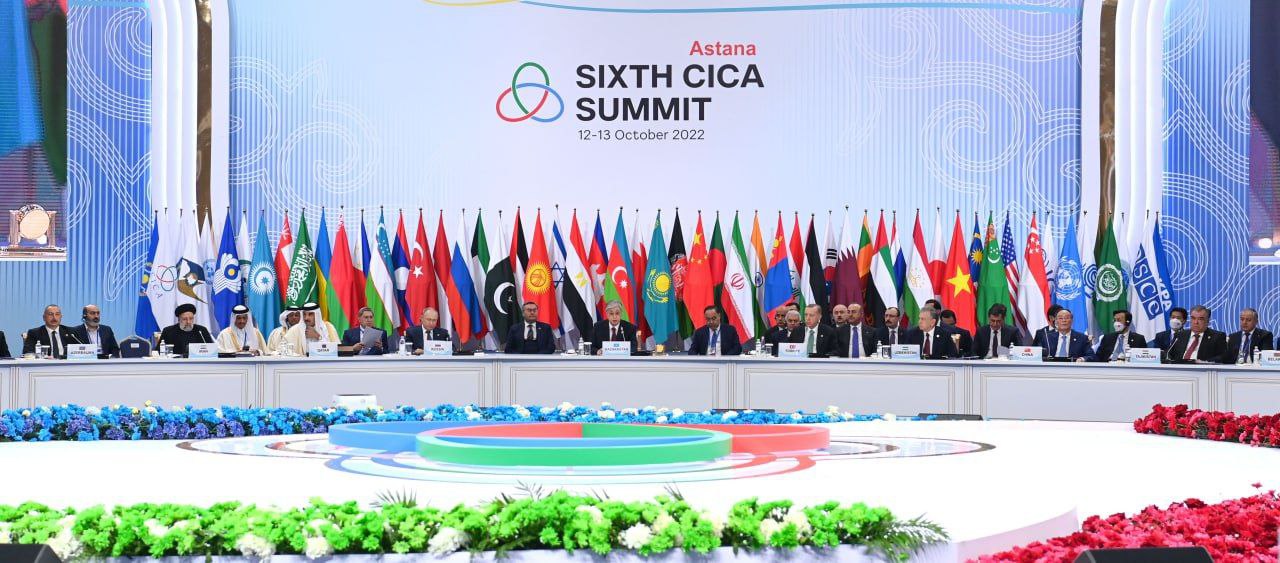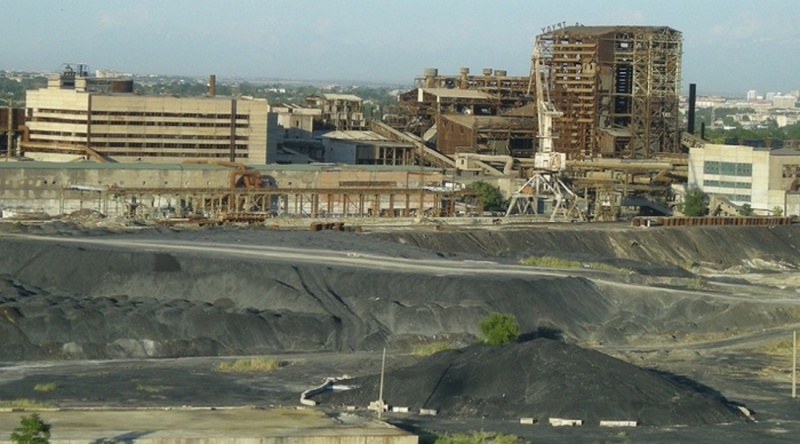Environmental problems of the south region
Ecological problems will be discussed in the capital of Kazakhstan

President Tokayev suggested holding a high-level conference in Astana on environmental issues in the CICA countries in two years, in 2024. The results of this meeting can become the basis for the creation of the CICA Council on cooperation in the field of ecology.
“The environmental dimension is becoming increasingly important. Climate change leads to natural disasters that have become increasingly unpredictable and catastrophic. In 2021, they affected 57 million people in Asia. By 2050, the possible damage to Asian economies from such natural disasters could be up to 26% of GDP,” the President said, referring to the powerful flood in Pakistan, which became a large-scale humanitarian disaster.
The climate crisis could lead to military conflicts and has already become a catalyst for huge and uncontrolled migration flows, Tokayev concluded.
https://orda.kz/sammit-svmda-o-chyom-govoril-kasym-zhomart-tokaev/
“The environmental dimension is becoming increasingly important. Climate change leads to natural disasters that have become increasingly unpredictable and catastrophic. In 2021, they affected 57 million people in Asia. By 2050, the possible damage to Asian economies from such natural disasters could be up to 26% of GDP,” the President said, referring to the powerful flood in Pakistan, which became a large-scale humanitarian disaster.
The climate crisis could lead to military conflicts and has already become a catalyst for huge and uncontrolled migration flows, Tokayev concluded.
https://orda.kz/sammit-svmda-o-chyom-govoril-kasym-zhomart-tokaev/
On the environmental problems of the South Kazakhstan region
The register of regional environmental problems of the South Kazakhstan region reflects 16 problems, such as air pollution in cities and other settlements, environmental pollution by unauthorized dumps of municipal waste, pollution of water bodies, etc.
The register of regional environmental problems of the South Kazakhstan region reflects 16 problems, such as air pollution in cities and other settlements, environmental pollution by unauthorized dumps of municipal waste, pollution of water bodies, etc. As you know, on the territory of the region, due to anthropogenic impact, the volumes of licorice root are sharply reduced, including due to illegal and uncontrolled extraction. This plant is not included in the list of rare and endangered plant species, therefore, criminal liability is not provided for illegal extraction of licorice root. There is also no administrative responsibility for the extraction of licorice root in lands not included in the forest fund.
The Environmental Prosecutor's Office has already sent relevant information to the Prosecutor General's Office with a proposal to initiate questions on amendments and additions to some legislative acts and to consider the issue of suspending the export of licorice root or limiting it to biologically justified amounts.
At the same time, in world practice there are other ways to solve this problem. Thus, the analysis showed that it is possible to grow and collect licorice root without damage to the environment. To do this, the specified activity should be streamlined by organizing activities for growing, collecting, processing and subsequent sale of the plant. Perhaps there is a need to include licorice in crops.
The proper organization of such activities, first of all, will exclude the facts of uncontrolled extraction of the plant and, accordingly, a reduction in its volume, jobs will be created, with the solution of social problems of the region, and in addition, this business will be taken out of the shadows.
Moreover, the audit conducted earlier by the environmental prosecutor's office showed that for more than 2 years, in almost all regions of the region, the akimats of cities and districts did not develop and did not submit for approval to maslikhats norms for the formation and accumulation of municipal waste, as well as tariffs for collection, removal, burial and utilization of municipal waste.
Such norms and tariffs have been developed and approved only in Saryagash, Otrar, Tulkuba and Ordabasy regions. For the city of Shymkent, only norms have been approved, tariffs have been developed and approved by the Maslikhat on the proposal of the environmental prosecutor's office.
In this regard, at a meeting of the Public Council in the environmental prosecutor's office, problematic issues of compliance with the law in the collection, transportation and storage of municipal waste, in the field of protecting green spaces that are not part of the forest fund, excessive air pollution, discharge of wastewater and treatment facilities, and illegal collection of licorice root, according to the results of which representatives of authorized state and local executive bodies were invited to conduct an appropriate analysis and, in a short time, make proposals for solving environmental problems of the region.
A source: https://nomad.su/?a=7-201412020012
Problems of atmospheric air pollution of the South Kazakhstan region
International Humanitarian and Technical University An environmental problem is a change in the natural environment, as a result of anthropogenic impact or natural disasters, leading to disruption of the structure and functioning of nature. South Kazakhstan region is one of the largest regions of the republic, its territory is 117.3 thousand square kilometers. In the west it borders on Kyzylorda, in the north - Karaganda, in the east - Zhambyl regions and the Kyrgyz Republic, in the south - the Republic of Uzbekistan. The region has 12 districts, 20 cities and towns, 838 rural settlements. South Kazakhstan region is located within the eastern part of the Turan lowland and the western spurs of the Tien Shan. About 50% of the territory belongs to the desert zone (sands of Kyzylkum, Muyukum, Betpak-Dala desert). The ecological situation in South Kazakhstan is becoming more and more urgent. In recent years, there are more and more sources of emissions of harmful substances into the environment of the region. With the increasing deterioration of the environment, the health status of the population of South Kazakhstan region is deteriorating. This presents environmental, economic and social problems for both the region and the country as a whole. The largest air pollutants in the South Kazakhstan region are concentrated in the city of Shymkent, they mainly form gross emissions of pollutants and affect the state of the region's air basin. The increase in the number of vehicles, especially in the regional center, is of particular concern. Emissions from vehicles due to its unsatisfactory technical condition have led to an excess of the maximum permissible concentrations for lead and formaldehyde, the total gross emission of which is about 98 thousand tons per year [1]. Shymkent city is one of the developed industrial centers of Kazakhstan with a large number of enterprises. More than 130 large enterprises in the region pollute the atmosphere with their emissions of harmful substances. The main share in atmospheric air pollution with nitrogen and sulfur oxides, formaldehyde falls on thermal power and motor transport enterprises, 2 hydrocarbons at petrochemical enterprises - Petro Kazakhstan Oil Products LLP (former Shymkent Nefteorg Synthesis JSC), lead - Yuzhpolymetal CJSC.
According to the data of the Kazgidromet State Enterprise, the state of air pollution in the regional center is assessed at 4 observation posts. The main criteria are the values of maximum permissible concentrations (hereinafter MPC) of pollutants in the air of populated areas. The average concentration of dust in Shymkent was 2.0 MPC, formaldehyde 5.3 MPC. The maximum of one-time concentrations of formaldehyde was 1.2 MPC (at PNZ # 2, Ordabasy Square), nitrogen dioxide 11.9 MPC (at PNZ # 3, Shymkentcement OJSC), and carbon monoxide 1.6 MPC (at PNZ # 3, OJSC "Shymkentcement"). The rest of the ingredients were within the acceptable range [2]. Significant increases in formaldehyde concentrations are noted during the summer months, due to increased traffic, poor quality gasoline and poor road conditions. The highest concentration of formaldehyde was found in the area of Ordabasy area. The growth in emissions of pollutants into the atmosphere is mainly associated with an increase in the number of vehicles, especially in the city of Shymkent. The total number of vehicles in the South Kazakhstan region accounted for by the city of Shymkent is 46.5%. Of particular concern is the unsatisfactory technical condition of vehicles. Emissions from vehicles due to its unsatisfactory technical condition have led to an excess of the maximum permissible concentrations for lead and formaldehyde. One of the environmental problems at present is the increasing anthropogenic load on the environment as a result of the accumulation of municipal solid waste (MSW) [2].
Accelerated rates of development of modern production, rapid population growth, increased consumption of industrial and household goods give rise to serious problems associated with waste disposal. Despite the current trend of recycling waste for recycling, which is observed in all industrialized countries of the world, the main method of disposal of waste is still its storage in the so-called "organized" dumps. This is the cheapest method of long-term waste storage - a source of soil, groundwater and air pollution. For the city of Shymkent, the problem of solid household waste is currently very relevant. The increase in the urban population, the development of industry and technological progress are causing the deterioration of the ecological conditions of life. In the 3rd city, there is an intensive accumulation of solid household waste, which, due to irrational and untimely disposal and neutralization, seriously pollute both the urban and the environment. The main "producers" of industrial waste in the South Kazakhstan region are such large enterprises as: JSC "Achpolimetal" with a waste volume of more than 170 million tons, JSC "Shymkent phosphorus" with a volume of 0.5 million tons (the area occupied by waste is about 30 hectares ), CJSC “Yuzhpolymetal” with a volume of 2.5 million tons, Kentau CHP-5 with a volume of 405.3 thousand tons, LLP “Petro Kazakhstan Oil Products” with a volume of 5.8 thousand tons, LLP “Spetsavtotransport” (landfill Shymkent) with a volume of more than 5.5 million tons and others. Separately, we can emphasize the accumulation of hazardous waste on the territory of the former phosphorus plant. A particular danger is represented by phosphorus-containing sludge, which must be stored under a layer of water in view of their fire-hazardous properties and tendency to spontaneous combustion. There is practically no waste disposal. Industrial waste in the region is generated mainly in two cities: Shymkent and Kentau. Industrial waste landfills are available at the following enterprises: CJSC “Yuzhpolymetal”, OJSC “Khimfarm”, LLP “Petro Kazakhstan Oil Products”, LLP “Water Resources – Marketing”, Central Mining Administration, JSC “Ontustik Kus”, JSC “Shymkent Shina”, JSC “Excavator”, waste from OJSC “Shymkent phosphorus”, “CHPP-5” OJSC, “Kentau liquidated mine” RSE. In addition, the branches of “Mining Company” LLP, “Stepnoye Ore Management” (STRU), “Centralized Transhipment Base” (TsAPB) generate two types of industrial waste - industrial non-radioactive waste of hazard class 4 and low-level radioactive waste. Low-level radioactive waste, the total amount of 1.07 thousand tons, is disposed of in a departmental disposal facility for low-level radioactive waste, which meets the requirements of SP LKP-98 and environmental legislation. One of the important problems is the disposal of radioactive waste, which includes spent ampoule sources of ionizing radiation. The issue of their centralized disposal has not been resolved, while in the region at 58 enterprises there are 3422 sources of ionizing radiation, of which 2494 have worked out the established period and belong to radioactive waste requiring disposal in a special storage facility at the Baikal-1 base of the Semipalatinsk test site. One of the most acute environmental problems in the region is the consequences of the liquidation and conservation of the Mirgalimsay mine in Kentau. According to the conclusion of the leading scientific research institutes of the republic, there is a real problem of groundwater pollution with toxic “tail” substances from concentration plants. According to calculations, only about 2% of all materials of nature involved in industrial production are processed into useful products, the remaining 98% become waste, that is, they are thrown into the environment. In the city of Shymkent, there is a municipal solid waste dump, for which a land plot of 45 hectares is allocated, and currently 22 hectares are used. The solid waste landfill operating in the city is poorly organized, waste disposal is carried out using outdated technologies and in violation of norms and rules. The Shymkent municipal solid waste dump is located outside the city in the northeastern part [3]. The expected service life of the landfill is 50 years - from 1980 to 2030. City dump of open type. Solid household waste accumulated on it pollutes the environment, causing irreparable harm to it. Garbage is discharged into natural ravines of the relief, followed by backfilling layer by layer with soil. More than 300 thousand cubic meters are taken out annually to the city dump of Shymkent. m of waste, in recent years they have accumulated about 5.5 million cubic meters of waste [5]. Also a serious problem is the widespread spontaneous landfills, which have a negative impact on the state of all components of the environment. 5 In addition to spontaneous dumps in the city of Shymkent, there are places of disorganized scattered garbage, mainly around the houses of public housing stock, next to public catering enterprises, shops, organizations of cultural and consumer services. Often there are unorganized separate heaps of garbage in waste trays (for the elimination of the specified pollution, funding is not required, since they can be eliminated through the introduction of organizational measures) [4]. All city dumps are open ground, water and pollute them. Most of the landfills are located without taking into account the wind rose. Hence the unpleasant odors, carbon monoxide, methane emitted from the mountains of garbage, as well as the multiplication of pathogenic microbes and the eternal companions of rodent dumps. It is not uncommon for toxic industrial waste to be taken to the city dump. Significant efforts are needed to move to a new quality of life, safe for humans, and to think confidently about the future of our children and the preservation of the natural environment. In the conditions of economic instability, reorganization of management structures, large investments are required to solve pressing environmental problems, especially important at the initial stage of the implementation of the environmental strategy. We need precise guidelines to ensure the long-term viability of social structures while moving along the highway of balanced nature management; strength of mind to abandon the usual lifestyle; the courage to turn the steering wheel hard. The fate of civilization depends on the decisions that will be made during the lifetime of the present generation.
International Humanitarian and Technical University
Shanaeva G.B. - senior group EG-214
Mamirova N.A. - Candidate of Agricultural Sciences, Associate Professor

‘Yuzhpolymetal’. Photo from the site blogs.ruvr.ru



